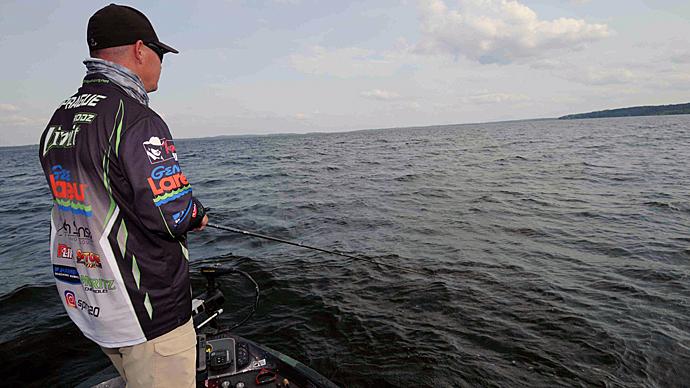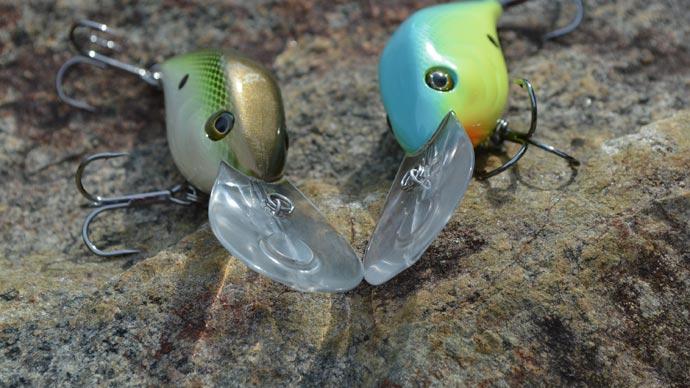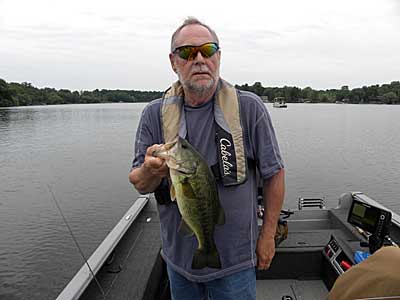
When can you honestly say that the bass begin their summer patterns? This will be a different answer all over the country and depend on where you live. Once the spawning season is complete, summer residency will start to take hold, and everything will balance out.
Find Them First
If you're fishing waters that you have been on before, you will generally have a good idea of some areas to check to see if they're holding fish or not. If you're fishing new waters, you will have to spend some time finding their summertime haunts. You can cut your time in half if you have a side imaging unit. This will allow you to look for offshore structures that the bass will occupy during the summer months.
I'm using a Humminbird Solix unit as my search unit, and I don't feel that there is a better unit for doing just this such thing. The images that Humminbird Mega+ give you will allow you to see transitions lines and hard to soft bottom areas. The imaging is so good and clear that you will see fish in these locations.
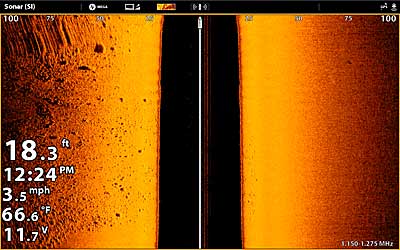
One key to look for during summer is to see if you can find deep bluegill beds with your side imaging. Bass will take up residence close to these particular areas, and they will have a built-in buffet dinner for their taking. I have been able to find a few of these areas sitting in deepwater through the years, and these areas have been like magic when you can find them.
Once you have got your deeper water scouting out of the way and have a few areas to check, it's time to grab a rod and get to work.
Crank And Rig
I'll start with a crankbait when I'm checking new areas. This is because I can make a quick pass to see what the area offers by way of hard bottom areas and the cover that exists. What I mean here is fishing with a crankbait. I can feel how the rocks are set, how good they are, and whether any weeds are mixed in.
I'm not looking for random rocks; I'm looking to feel groups of rocks in a small area. These areas will mainly hold schools of bass, not just a bass here and there. A group of rocks will hold more bass as it has more area to offer to the bass and the forage that they are chasing. You will get more crawfish living in a pile of rocks than you will one rock here and another one there.
What are the results once you have made a few passes with the crankbait? Drop a few waypoints on the critical structure pieces if you got on fish, and you'll be set to return. Don't leave the areas just yet if you had a few bites. I'll often pick up a Carolina rig and go through these areas again. It could be the bass are not active enough to take or chase down a crankbait. A slower bait may just be the ticket.
There is also another reason that I chose a Carolina rig. The 1oz sinker also helps me learn the area better. You will be amazed at what you can tell with a 1oz sinker as you drag it across the bottom.
I have always said my best spots are where I have difficulty getting the Carolina rig through the rocks. I call this nasty rock. You will have a hard time getting your sinker through these areas. You may even get hung up. This is an area that you need to pay special attention to. This is where most of the big bass from the area live, and many times, it's not just one big bass. It's multiple big bass.
Here are a few other factors that you will have to pay attention to as the summer goes on in your area. The first one is water clarity. This pattern excels in off-color bodies of water. I'm not talking dirty water areas where the bass can't see a foot in front of them. I'm talking stained bodies of water, where they can see 2ft to 3ft. You won't get big bass populations past 20ft of water, so it is easier to get a crankbait down to these areas.
The second factor will be the thermocline. As the summer goes on, remember you'll have to stay shallower than the thermocline in your body of water. Bass and other game fish won't travel deeper than the thermocline where there's little or no oxygen. So, as the summer goes on, check for the depth of the thermocline in your body of water. If it does thermocline, make sure you pick areas to fish shallower than the thermocline.
Setup Breakdown
Crankbaits
First, let's break down the crankbait setup and keys. My two favorite crankbaits to use as search tools and when targeting bass in these situations will be a Rapala DT16 & 20ft and a Strike King 6XD. These baits are very different from each other, so that alone expands my options. I'll fish both baits on a Denali Attax 7’10” Heavy Glass cranking rod. I have a Lew’s BB-1 rel geared at 6.4:1 spooled with 10lb Sunline Crank FC for the Rapala crankbaits. And for the 6XD, I use the same rod and reel combo, but this reel is spooled with 14lb to 16lb Crank FC. For the bigger 6XD, I beef up the line a little.
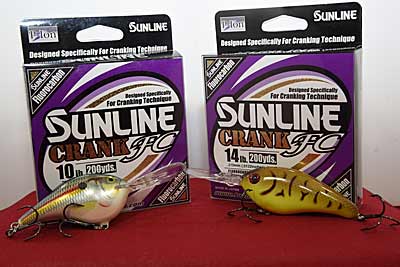
Make your cast and lower your rod tip to within a foot of the water’s surface and start cranking. This will allow your bait to reach its deepest possible depth. For every foot you're above the water’s surface with your rod tip, that is one less foot that your bait can reach.
Your goal is to feel your bait working along the bottom. Pay attention to how the bait is running. Are you feeling rock, or is the bottom clean? That is essential information. Very rarely will bass sit on open areas unless they're chasing a food source.
When you feel rock, mark a waypoint so that you can break down these key areas better with both your crankbait and Carolina rig.
Spend time in these critical areas and figure out where the bass are set up when feeding and where they go when they are not feeding. It will be easier to trigger bites, but changes in moods and locations will force you to try to catch bass in those off times as well. So you're best to try to figure out both patterns if needed. Many times, they won't move far; check the area thoroughly.
Carolina Rigs
I have been fishing a Carolina rig for years, and it makes the best crankbait backup choice out there in all conditions. The biggest reason is that you can run a crankbait through an area, take the active bass, and then follow up with a Carolina rig and get the neutral bass to bite. On a day-to-day basis, the Carolina rig will take the bigger bass hands down. I would take a Carolina rig any day if you gave me one presentation to fish for big deepwater bass.
I fish my Carolina rig set up on a Denali Lithium L884WJ Heavy Worm & Jig rod. This is the perfect rod to handle the extra weight (1oz sinker) and line needed to cast a good distance when Carolina rig fishing.
I have changed how I rig my Carolina rig through the years. I have used lead most of the time until a few years back. Yes, tungsten will give me a better feel of the bottom content, but the number of rigs that I go through would cost me a pretty penny to keep supplied with 1-ounce tungsten sinkers. So I have found an alternative at a far reduced cost. I have changed from lead to steel. Steel sinkers made by Bullet Weights offer significant savings from tungsten. Steel gives me a better feel than lead. It's a little bit bigger but has a better feel, so I get more information about what I'm fishing than before.
One aspect that I can tell you is some of my best spots have been when the rock areas are compact in a smaller area. These areas hold numbers of bass, not just a bass here and a bass there. Many times, there are schools of bass in these areas. But the downside of that is you'll have a hard time getting a Carolina rig through these areas clean without snagging up from time to time. So be careful and work your bait through these areas with a bit of finesse. If you get snagged, it's done for some time. You will have to come back and try again after the school settles again.
I hope these deepwater summertime tactics help you get on more and bigger bass this year. Crankbaits and Carolina rigs make the perfect pair to break these areas down and get the bass going. Use this one-two punch to your advantage to help you put more bass in your boat.


